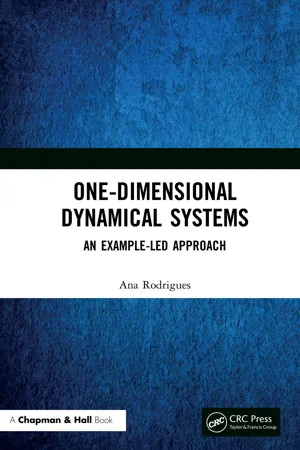
- 100 pages
- English
- ePUB (mobile friendly)
- Available on iOS & Android
eBook - ePub
About this book
For almost every phenomenon in physics, chemistry, biology, medicine, economics, and other sciences, one can make a mathematical model that can be regarded as a dynamical system. One-Dimensional Dynamical Systems: An Example-Led Approach seeks to deep-dive into ? standard maps as an example-driven way of explaining the modern theory of the subject in a way that will be engaging for students.
Features
-
- Example-driven approach
-
- Suitable as supplementary reading for a graduate or advanced undergraduate course in dynamical systems
Frequently asked questions
Yes, you can cancel anytime from the Subscription tab in your account settings on the Perlego website. Your subscription will stay active until the end of your current billing period. Learn how to cancel your subscription.
At the moment all of our mobile-responsive ePub books are available to download via the app. Most of our PDFs are also available to download and we're working on making the final remaining ones downloadable now. Learn more here.
Perlego offers two plans: Essential and Complete
- Essential is ideal for learners and professionals who enjoy exploring a wide range of subjects. Access the Essential Library with 800,000+ trusted titles and best-sellers across business, personal growth, and the humanities. Includes unlimited reading time and Standard Read Aloud voice.
- Complete: Perfect for advanced learners and researchers needing full, unrestricted access. Unlock 1.4M+ books across hundreds of subjects, including academic and specialized titles. The Complete Plan also includes advanced features like Premium Read Aloud and Research Assistant.
We are an online textbook subscription service, where you can get access to an entire online library for less than the price of a single book per month. With over 1 million books across 1000+ topics, we’ve got you covered! Learn more here.
Look out for the read-aloud symbol on your next book to see if you can listen to it. The read-aloud tool reads text aloud for you, highlighting the text as it is being read. You can pause it, speed it up and slow it down. Learn more here.
Yes! You can use the Perlego app on both iOS or Android devices to read anytime, anywhere — even offline. Perfect for commutes or when you’re on the go.
Please note we cannot support devices running on iOS 13 and Android 7 or earlier. Learn more about using the app.
Please note we cannot support devices running on iOS 13 and Android 7 or earlier. Learn more about using the app.
Yes, you can access One-Dimensional Dynamical Systems by Ana Rodrigues in PDF and/or ePUB format, as well as other popular books in Physical Sciences & Applied Mathematics. We have over one million books available in our catalogue for you to explore.
Information
CHAPTER 1
Introduction
For almost every phenomenon from physics, chemistry, biology, medicine, economics and other sciences one can make a mathematical model that can be regarded as a dynamical system.
Our goal is to understand the eventual or asymptotic behaviour of an iterative process.
If this process is a differential equation whose independent variable is time, then the theory aims to predict the behaviour of solutions of the equation when either or .
When studying discrete dynamical systems, we are interested in investigating the sequence of iterates
The main questions we are going to deal with are whether the system exhibits chaotic behaviour or whether it is periodic.
Let us start by introducing some basic concepts that we will use throughout this book.
We say a point xf is a fixed point for our function f if .
The forward orbit of a point x is the set of points (note that here denotes the nth-iterate of our function) and we usually denote this orbit by . When f is a homeomorphism we can define the full orbit of our point x as the set of points for . The same way we can think about the backward orbit of our point x and we denote it by .
An important concept in dynamical systems are the periodic points. A point x is said periodic of period n if . The least positive n for which this relation holds is called the prime period of x. We will refer to the set of periodic points of period n by .
We can also talk about eventually periodic points, this occurs when there exists a natural number such that for all ) (in a sense is periodic of period n for ).
Finally, we say that a point x is forward asymptotic to p if
Here it is important to note that the stable set of p is the set of all points that are forward asymptotic to p and we usually designate it by .
Let us see what happens to the map (see Figure 1.1). To find the fixed points, we must solve the equation , that is, the quadratic equation which gives us the fixed points . Now, we have and so it is clear that is a periodic point for f of period 2.

Figure 1.1: Plot of the map . The diagonal has been drawn in to illustrate the positions of the fixed points at (that lie along the diagonal) and the path of the periodic points as a web diagram under iteration.
Another important concept is the one of the critical point. These are the points where the first derivative vanishes, this is, the points x such that . If we consider again the function , we see that and so, 0 is a critical point for thi...
Table of contents
- Cover
- Half Title
- Title
- Copyright
- Contents
- Chapter 1 Introduction
- Chapter 2 Rotation numbers
- Chapter 3 Topological conjugacy
- Chapter 4 Critical points
- Chapter 5 Topological theory of chaos
- Chapter 6 Symbolic dynamics
- Chapter 7 Tongues
- Bibliography
- Index